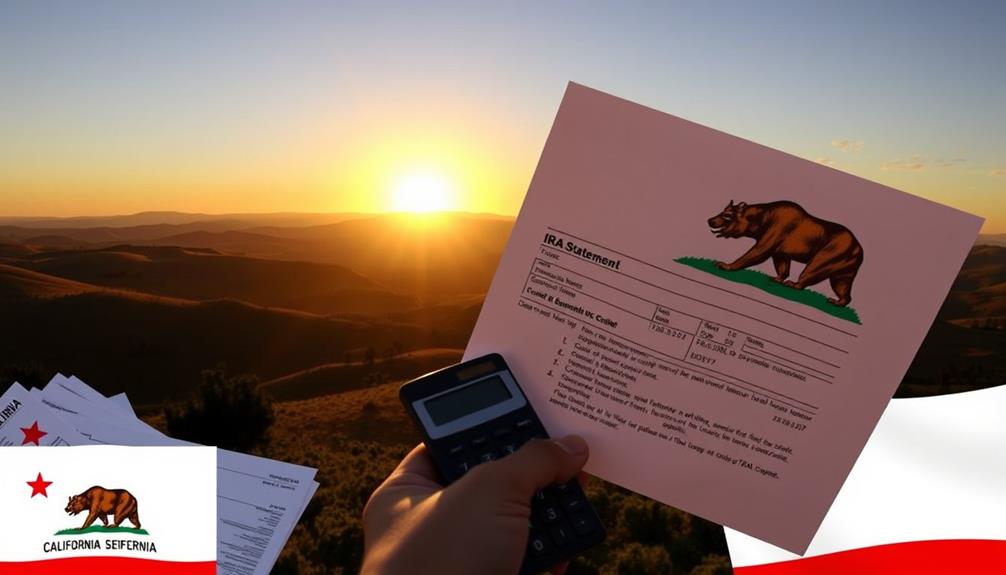When you are planning for your retirement in Alaska, it is crucial to consider how to integrate your IRAs with state-specific benefits in order to maximize your savings. Alaska does not have a state income tax, which means you can benefit from tax-free withdrawals from your IRAs, ultimately increasing your after-tax income. Additionally, don’t overlook the Permanent Fund Dividend, which can provide you with extra cash to boost your retirement budget. Developing a strategy for your withdrawal plans that aligns with other sources of income such as Social Security can help reduce tax implications. By taking advantage of benefit programs and engaging in financial planning, you can significantly enhance the quality of your retirement. Discovering and implementing these strategies can offer you the financial stability necessary to thrive in Alaska’s unique landscape.
Key Takeaways
- Traditional and Roth IRAs offer tax advantages in Alaska, with no state income tax enhancing overall retirement savings and income retention.
- The Permanent Fund Dividend (PFD) provides annual tax-free cash payments, boosting retirement income for eligible Alaskan residents.
- Cost of living adjustments (COLA) are essential for managing retirement budgets, particularly for retirees relying on fixed incomes.
- Medicare coverage, alongside AlaskaCare benefits, is crucial for managing healthcare costs in retirement, impacting financial planning.
- Tailored financial planning strategies are necessary for integrating IRAs with state-specific benefits to optimize retirement income and expenses.
Understanding IRAs in Alaska

When planning for retirement in Alaska, understanding the nuances of Individual Retirement Accounts (IRAs) is essential. You can choose between Traditional IRAs and Roth IRAs, each offering different tax advantages.
With Traditional IRAs, you enjoy tax-deferred growth, meaning you won't pay federal income tax on your contributions until you withdraw funds in retirement. On the other hand, Roth IRAs allow for tax-free withdrawals, provided you meet specific criteria.
You can contribute up to $6,500 annually to these retirement accounts, or $7,500 if you're 50 or older, though income limits may affect your eligibility for Roth IRAs.
One significant advantage of living in Alaska is the absence of state income tax. This feature enhances your retirement income planning since you maximize your after-tax income when withdrawing from your IRA.
Additionally, if you have qualified retirement plan distributions, you can roll them over into your IRA without incurring taxes. This flexibility allows you to manage your retirement accounts effectively and guarantee your financial stability in retirement.
Understanding these options will help you make informed decisions for your future in Alaska.
Benefits of No State Income Tax

When you retire in Alaska, the lack of a state income tax offers significant financial advantages, allowing you to keep more of your hard-earned savings.
This benefit not only enhances your investment opportunities but also simplifies your overall tax planning.
By considering options like a Gold IRA, you can further diversify your retirement portfolio and take advantage of potential tax-deferred growth, providing a hedge against inflation and economic downturns Gold IRA advantages.
With more disposable income, you can focus on enjoying your retirement without the burden of additional state taxes.
Financial Advantages for Retirees
One of the major financial advantages for retirees in Alaska is the absence of a state income tax, which allows you to retain more of your hard-earned retirement income.
This tax-friendly environment means that your pensions, Social Security benefits, and IRA withdrawals won't be subjected to additional taxes, leading to significant savings. With no state income tax, you can better manage your budget and spending, enhancing your overall financial well-being.
For those relying on fixed incomes, this benefit becomes even more important. Without the burden of state income tax, you'll find it easier to stretch your retirement dollars further, ensuring a more comfortable lifestyle.
Alaska's retirement scene not only offers stunning natural beauty but also the financial relief of reduced tax liability compared to states with high income taxes.
When you're engaged in retirement planning, consider how Alaska's unique advantages can help you maintain your desired quality of life.
Enhanced Investment Opportunities
Alaska's lack of a state income tax not only boosts your retirement income but also opens doors to enhanced investment opportunities. With no state tax on your earnings or IRA withdrawals, you can maximize your retirement savings, allowing you to allocate funds toward diverse financial products like stocks, bonds, and real estate. This tax-friendly environment in Alaska lets you strategically plan your withdrawals, optimizing your overall tax situation.
Here's a breakdown of how these benefits can impact your retirement:
| Benefit | Impact on Retirement |
|---|---|
| No state income tax | Keep more of your income |
| Tax-free IRA withdrawals | Maximize available funds for living expenses |
| Increased disposable income | Invest in a range of financial products |
| Lower overall tax liability | Enhance your retirement lifestyle |
| Greater wealth accumulation | Secure a financially stable future |
Simplified Tax Planning
Retirement planning can feel overwhelming, but the absence of a state income tax in Alaska simplifies the process considerably. This tax-friendly environment allows you to maximize your retirement benefits and maintain your financial security.
Here are three key advantages:
- Social Security Benefits: You keep more of your Social Security benefits because they aren't taxed by the state, ensuring a larger portion of your income remains intact.
- Pension Income: If you receive defined benefit pensions, you'll appreciate that Alaska doesn't tax this income, allowing you to enjoy the full amount without deductions.
- IRAs Withdrawals: Withdrawals from your IRAs are free from state income tax, giving you flexibility in managing your retirement savings and spending.
In addition, Alaska's lack of estate or inheritance taxes further enhances its appeal for retirees.
This means that when you're planning for the future, you can focus on growing your savings without worrying about additional state-level tax liabilities.
With these advantages, you'll find that retirement in Alaska can be a financially rewarding experience.
Exploring the Permanent Fund Dividend

Offering a unique financial boost, the Permanent Fund Dividend (PFD) provides eligible residents of Alaska with an annual cash payment derived from the state's oil revenue.
If you've lived in Alaska for the entire previous calendar year, you may qualify for this benefit. To receive the PFD, make sure you submit your application before the deadline, typically set for March 31 each year.
In 2023, the PFD amount was $1,300 per qualifying resident, which can vary based on fluctuations in oil revenue and investment performance.
This annual payment can greatly enhance your retirement income, especially if you're on a fixed income. Many Alaska residents use the PFD for savings, direct deposits into bank accounts, or everyday expenses, reinforcing its role as an essential financial resource.
One of the standout features of the PFD is that it's not subject to state income tax, adding another layer of financial advantage for residents.
As you plan for retirement in Alaska, integrating the Permanent Fund Dividend into your financial strategy can provide considerable support and help you achieve your retirement goals with greater ease.
Integrating Medicare With Retirement Plans

When you turn 65, enrolling in Medicare Parts A and B is essential for your retirement health coverage.
It's important to evaluate your options, as understanding the benefits of Medicare versus other plans can impact your retirement budget.
Additionally, if you plan to work after retiring, you'll need to take into account how that affects your Medicare eligibility and benefits.
Medicare Enrollment Requirements
Maneuvering the complexities of Medicare enrollment is essential for Alaskan retirees aiming to maximize their healthcare coverage. As an AlaskaCare member, enrolling in both Medicare Parts A and B at age 65 is important for accessing enhanced health coverage.
Here are three key points to keep in mind:
- Medicare Part A covers hospital stays and skilled nursing, while Part B requires a premium for outpatient services, which can greatly impact your overall retirement healthcare costs.
- Prescription drug coverage under Medicare Part D is critical for managing medication expenses; consider AlaskaCare's additional benefits to guarantee you're well-protected.
- If you plan to engage in reemployment, be aware that it may affect your Medicare eligibility and benefits, potentially limiting access to certain health insurance plans.
Retirees should review Medicare options and benefits annually as part of their retirement planning. This regular assessment guarantees you're optimizing your health coverage and minimizing healthcare costs.
Coverage Options Comparison
Maneuvering the interplay between Medicare and your retirement plans can greatly affect your healthcare coverage in Alaska. For retirees, understanding how Medicare Part A and Part B integrates with plans like AlaskaCare or the PERS can be essential.
Medicare Part A provides fundamental coverage for hospitalization and skilled nursing, which complements the health benefits you receive from your retirement plans after your years of service.
As a retiree, you'll want to enroll in both Medicare Parts A and B by age 65. This step is important since AlaskaCare assumes this enrollment, allowing you to access enhanced prescription drug coverage under Part D.
By combining these resources, you can guarantee thorough healthcare support during retirement.
Effective financial planning means considering how Medicare's coverage interacts with your retirement benefits. It can greatly minimize out-of-pocket costs for medical services, ultimately impacting your overall retirement income.
For PERS members and others in similar plans, leveraging Medicare can lead to a more secure and financially sound retirement, guaranteeing you have the health care support you need when it matters most.
Impact on Retirement Benefits
Understanding the impact of Medicare on your retirement benefits is fundamental for guaranteeing you have adequate healthcare coverage in Alaska. As you approach retirement, it's important to recognize how Medicare integrates with your benefits, particularly through programs like AlaskaCare.
Here are three key points to reflect on:
- Enrollment Timing: Medicare enrollment typically begins at age 65 for AlaskaCare members, so plan ahead to avoid gaps in coverage.
- Costs and Coverage: While Medicare Part A offers hospitalization without a premium, Part B requires monthly premiums that could affect your budget. Understanding these costs is essential for financial stability in retirement.
- Enhanced Prescription Coverage: AlaskaCare enhances Medicare Part D, providing retirees with better prescription drug coverage, which is significant for managing healthcare expenses.
Retirees returning to work may also face changes in their Medicare eligibility and benefits.
Consequently, analyzing your employment options post-retirement is fundamental to maintain integrated benefits. By understanding these aspects, you can guarantee thorough healthcare coverage and safeguard your retirement benefits.
Cost of Living Adjustments for Retirees

Retirees in Alaska face unique financial challenges due to the state's high cost of living, but Cost of Living Adjustments (COLA) can provide essential support. These adjustments help guarantee that your purchasing power remains stable against inflation.
For members of the Public Employees Retirement System (PERS), COLA eligibility requires residency in Alaska, allowing you to receive at least $50 or 10% of your base retirement benefit.
If you're a member of the Teachers Retirement System (TRS), you also receive a COLA of 10% of your base retirement benefit, but without a minimum amount.
These COLA adjustments are vital, especially considering the rising costs in places like Anchorage, where the consumer price index is regularly reviewed. This annual assessment allows for potential increases in COLA rates, helping you better manage the cost of living increases that can noticeably impact your finances.
Health Insurance Options for Seniors

Maneuvering health insurance options can be intimidating for seniors living in Alaska, but knowing what's available can make a significant difference in your care. As a retiree, you have several important coverage options to evaluate:
- Medicare Parts A & B: Upon turning 65, enrolling in these parts provides essential hospitalization and outpatient service coverage.
- AlaskaCare: This plan complements Medicare, enhancing your benefits with coverage for dental, vision, and auditory needs, along with Medicare Part D for prescription drugs, lowering your out-of-pocket costs.
- Division of Retirement Benefits: This resource offers guidance on your eligibility for health insurance benefits and informs you about any implications of reemployment on your coverage.
Understanding these aspects is vital as they directly affect your healthcare access and costs.
Be certain to explore all options, and don't hesitate to reach out to the Division of Retirement Benefits for personalized assistance.
Reemployment Policies After Retirement

Steering through reemployment policies after retirement in Alaska can be essential for those looking to supplement their income. Understanding the rules will help you make informed decisions regarding your retirement benefits.
Here's a quick overview of key considerations:
| Employment Type | Impact on Retirement Benefits | Notes |
|---|---|---|
| Private Companies | No limitations; benefits remain intact | Ideal for income supplementation |
| Out-of-State Government | No limitations; benefits remain intact | Great option for retirees |
| Temporary/Nonpermanent Positions | No impact on retirement benefits | Provides flexible work options |
| Permanent Positions with PERS/TRS | Suspension of benefits until employment ends | Must apply for additional retirement benefits |
| Early Retirement | Reduced benefits, impacting reemployment choices | Consider normal retirement age |
If you're considering returning to work, be mindful that reemployment with PERS employers leads to suspension of benefits. However, temporary work allows you to earn additional income while preserving your retirement benefits. Always check your credited service and the implications of early retirement before making a move.
Survivor and Divorce Benefits Overview

Understanding how retirement benefits work during significant life changes like divorce or the passing of a spouse is vital for financial planning. In Alaska, retirement benefits are treated as jointly owned, which means they can be divided during a divorce. Here are some key points to take into account:
- A Qualified Domestic Relations Order (QDRO) is necessary if you want to divide retirement benefits, but it's not needed if one spouse keeps full ownership.
- Survivor benefits, elected at retirement, guarantee that your designated spouse remains the sole beneficiary even after a divorce, barring any changes.
- Access to medical coverage may be part of these survivor benefits, offering enhanced financial security for the surviving spouse.
It's important to remember that if you don't update your benefits after a divorce, your former spouse could still receive survivor benefits without a QDRO.
This can impact your plans, especially if you wish to designate a new beneficiary later. Being informed and proactive about these aspects can help you navigate the complexities of retirement planning in Alaska effectively.
Strategies for Efficient Withdrawals

When it comes to planning your withdrawals from retirement accounts in Alaska, you're in a unique position due to the absence of state income tax. This allows you to withdraw funds without incurring state-level taxation. To guarantee Retirement Security, focus on efficient withdrawal strategies that prioritize tax-deferred accounts like IRAs first.
Aligning your withdrawals with other income sources—such as Social Security and your pension—can help manage your overall tax liability and avoid higher federal tax brackets. Regularly reviewing these strategies is crucial, especially in light of your financial needs, the Alaska Cost of Living Allowance (COLA), and market conditions.
Here's a quick overview to guide your withdrawal planning:
| Withdrawal Source | Considerations |
|---|---|
| Tax-Deferred Accounts | Maximize tax-free growth |
| Social Security | Coordinate timing to minimize tax |
| Pension | Factor into total income |
| Retiree Health Plan | Include healthcare costs in budget |
Consulting with a Financial Planner can guarantee that your strategy remains effective as your situation evolves. By being proactive, you'll enhance your financial stability throughout retirement.
Frequently Asked Questions
Can You Combine State and Federal Retirement?
Yes, you can combine state and federal retirement benefits. By strategically integrating sources like Social Security and IRAs, you enhance your retirement income, ensuring a more robust financial foundation for your future.
What Is the State of Alaska Supplemental Annuity Plan?
Did you know that participants in Alaska's Supplemental Annuity Plan can boost their retirement savings considerably? This plan allows you to make voluntary contributions, which your employer matches, enhancing your overall financial security for retirement.
What Is the Alaska Post Retirement Pension Adjustment 2024?
The Alaska Post Retirement Pension Adjustment for 2024 offers eligible PERS retirees annual increases based on the Anchorage Consumer Price Index. You'll need to apply to confirm your eligibility and receive these adjustments.
Is Alaska Tax Friendly for Retirees?
Yes, Alaska's tax-friendly for retirees. You'll enjoy no state income tax, exempt Social Security benefits, and pension income. Plus, there's no estate or inheritance tax, allowing more financial flexibility for your retirement planning.
Conclusion
In Alaska, crafting your retirement plan is like traversing a vast, beautiful wilderness. With no state income tax and unique benefits like the Permanent Fund Dividend, you can maximize your savings. By integrating your IRAs with state-specific advantages, health insurance options, and strategies for efficient withdrawals, you're setting yourself up for a secure future. Embrace the journey ahead, knowing that careful planning today can lead to a prosperous and fulfilling retirement in the Last Frontier.
Helen brings a wealth of experience in investment strategy and a deep passion for helping individuals achieve their retirement goals. With a keen understanding of market dynamics, Helen has been instrumental in shaping the vision and direction of Gold IRA Markets. She specializes in creating innovative solutions that align with our clients’ long-term investment objectives.









